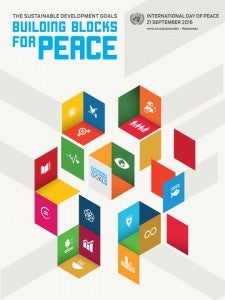 Each year since 1981, the United Nations (UN) recognizes an International Day of Peace on September 21. The day is intended to strengthen peace both within and among nations.
Each year since 1981, the United Nations (UN) recognizes an International Day of Peace on September 21. The day is intended to strengthen peace both within and among nations.
As an environmental advocate, I can’t help but think about the effects of climate change on the current state of global peace. And while there are a few climate deniers out there, those who have looked at the science are saying climate change poses a serious threat to global security and peace.
Fortunately, the UN agrees – which is why they chose to focus this year’s International Peace Day on Sustainable Development Goals. Unanimously adopted by all 193 UN member states, the Sustainable Development Goals are broken down into 17 focus areas and are part of a broader agenda to fight inequality, injustice, and climate change by 2030.
Goal 7 – “ensure access to affordable, reliable, sustainable, and modern energy for all” – is a hugely important part of fostering global peace. The world needs affordable, reliable electricity to heat, cool, and power our homes, and to encourage economic growth. But we also need this electricity to be clean, modern, and efficient, so it doesn’t pollute our communities and exacerbate climate change.
Here are four ways the U.S. is doing our part to achieve an affordable, reliable, sustainable, and modern energy system for all:
[Tweet “Why Clean Energy is Center Stage on International Day of Peace”]
- Affordability: In rural, poverty-persistent parts of the country, energy efficiency is the most direct way to save people money and reduce energy use, but it is often overlooked when families face hard choices about where to spend their money. On-bill financing is one solution that’s helping Americans finance energy efficiency upgrades without the burden of upfront costs. Upgrades are paid for over time (via utility bills) from the resulting energy savings of efficiency improvements. The program reduces energy use and saves people money, which is especially important in rural communities where median household incomes are shrinking compared to their urban and suburban counterparts. In North Carolina, non-profits like Environmental Defense Fund (EDF) and electric cooperatives (or “co-ops,” which supply power to 42 million Americans in rural areas) are partnering to expand on-bill financing.
- Reliability: Electricity touches everything we do. So when the grid goes down, the effects can range anywhere from inconvenient to life-threatening. With the help of smart meters, which now exist in nearly half of U.S. households and deliver detailed energy-use data to utilities, we can begin to identify outages faster and with great precision (meaning shorter outages). Smart meters can also enable energy management tools like demand response – which pays people to reduce energy when the electric grid is stressed – that can help improve reliability and reduce outages. New York recently approved an historic plan by its largest utility to distribute smart meters to millions of homes. This move will help increase efficiency, improve reliability, and lower pollution.
- Sustainability: An estimated 6% of U.S. energy use is water-related. That’s equivalent to the annual electricity consumption of 40 million Americans. Ensuring a sustainable future means addressing the way we manage our electricity and our water – part of what’s known as the “energy-water nexus.” Based in Austin, Texas, Pecan Street, Inc., the nation’s largest energy research network and an EDF partner, is studying and piloting some of the same strategies that are helping the energy sector get smart. Just like smart energy meters, smart water meters can help residents conserve resources by giving them access to meaningful data about when and how they use water. By saving water, we can save energy, too, which means fewer polluting power plants.
- Modernity: A key aspect of modern energy is that it should be accessible to all. While the price of solar panels has fallen 80 percent since 2008, many Americans reside in multi-unit buildings, or don’t own a home on which to install solar panels. But the solar game is changing and new models are emerging. Community solar, defined as “a solar-electric system that provides power and/or financial benefit to, or is owned by, multiple community members,” presents a unique opportunity to bring solar access to the masses. Cities like Los Angeles, California and San Antonio, Texas are actively working to expand community solar. And nationally, community solar is predicted to more than double between 2015 and 2016.
Global consensus
These examples reveal the new look of energy in America. Other nations are making clean energy progress, too, though their circumstances vary. For example, in Lesotho, Southern Africa, clean energy sometimes looks like solar panels on homes in rural areas that can’t be reached by vehicles. In Chennai, India, clean energy can be seen in the solar steam cooking system in a home-school for 650 orphans.
Yet, despite regional differences, this International Day of Peace – with Goal 7: Affordable and clean energy at center stage – reminds us that around the world, efforts to nurture a safer, more prosperous future are cut from the same cloth. It’s also a reminder that the world agrees with Secretary-General Ban Ki Moon’s message: “Affordable, clean energy is the golden thread that links economic growth, increased social equity, and a healthy environment.”
This post is part of a series produced by The Huffington Post to mark the occasion of the one-year anniversary of the adoption of the Sustainable Development Goals (SDGs, or, officially, “Transforming Our World: the 2030 Agenda for Sustainable Development”). The SDGs represent an historic agreement — a wide-ranging roadmap to sustainability covering 17 goals and 169 targets — but stakeholders must also be held accountable for their commitments. To see all the posts in the series, visit http://www.huffingtonpost.com/news/sustainable-development-goals.









